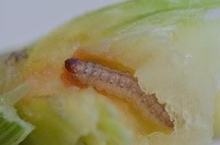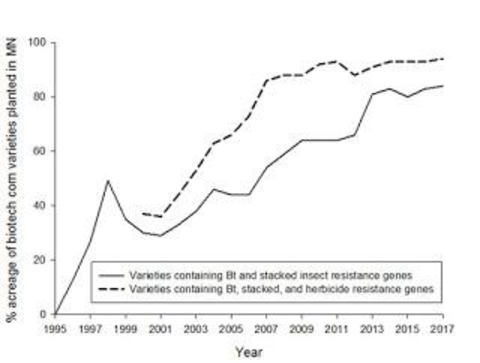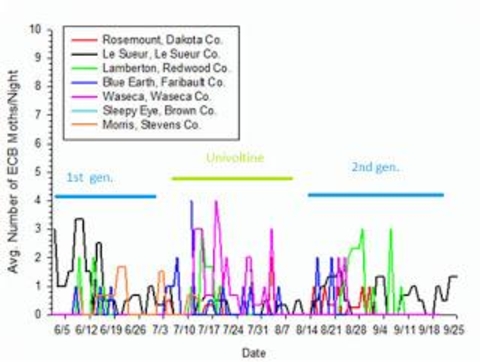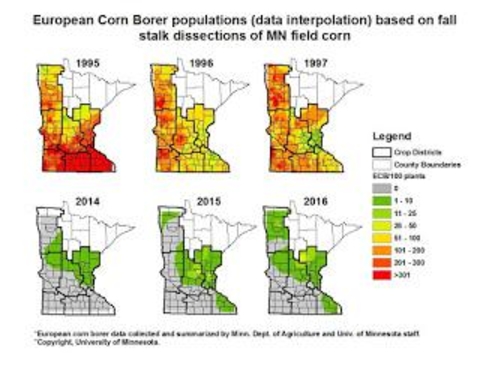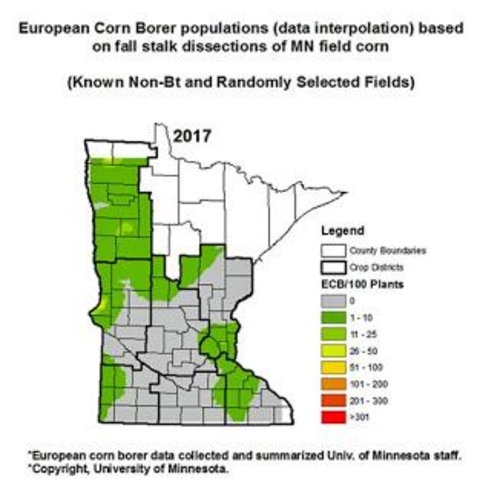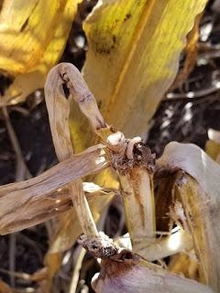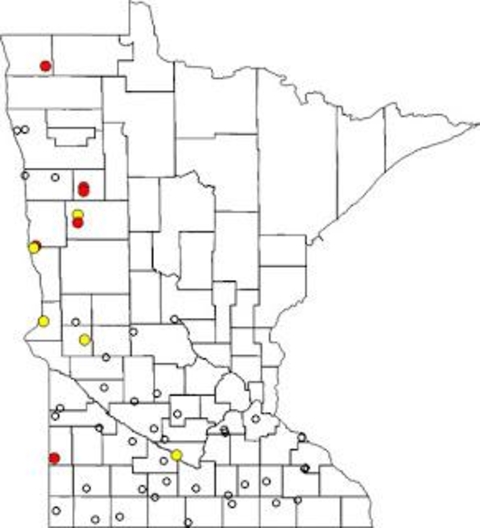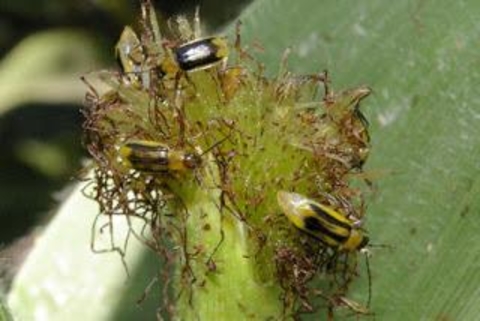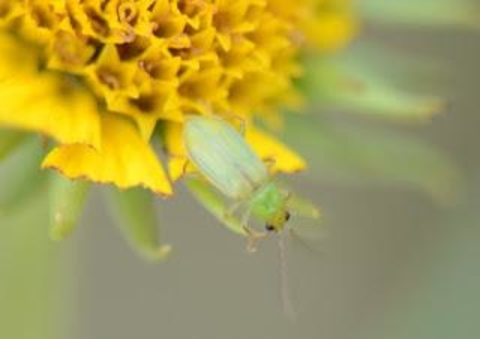The economics of corn production challenge many farmers with minimizing losses per acre. One area some farmers have targeted for reducing costs is hybrid selection.
Planting corn hybrids without Bacillus thuringiensis (Bt) proteins for protection against European corn borer (ECB), corn rootworm or both will greatly reduce seed costs.
Yield potential
However, if you’re not careful, you could inadvertently reduce crop revenues if you select hybrids without considering yield potential or insect populations in your fields.
Yield potential is the first thing to consider when selecting a corn hybrid. Bt traits only protect the yield potential of a hybrid; yield benefits only occur when targeted insects are above economic levels.
When insect pressure is low or absent, economic benefit with trait-protected hybrids only occurs if higher costs are offset by greater yields. Switching to less expensive non-Bt seed can be a good strategy when yields are comparable or when seed cost savings exceed any reduced yield potential plus prospective insect losses.
Planting corn without a Bt trait can work in many fields, if you recognize your insect risk.
European corn borer (ECB)
Historical ECB population
Since the adoption of Bt corn more than 20 years ago, Bt use rates in Minnesota have grown to approximately 80 percent of the total acres planted (Figure 1). ECB populations throughout most of the Midwest Corn Belt have been effectively suppressed by a similar adoption of Bt.
ECB populations continue to be low in Minnesota where Bt use has remained relatively high since 2007. Low ECB moth flights (Figure 2) parallel the low ECB larval populations detected in the fall surveys (Figures 3 and 4).
2017 ECB population
In 2017, the Minnesota Corn Research and Promotion Council provided funding to increase the number of fields surveyed for ECB damage and overwintering larvae (Figure 5) the previous fall.
As part of the project, several farmer cooperators volunteered non-Bt fields for the survey. Importantly, this cooperation allowed us to sample 52 fields that we knew in advance didn’t have above-ground Bt traits (Figure 6).
These fields greatly contributed to our understanding of the current spatial pattern of ECB in the state and revealed where ECB might gain a foothold in non-Bt fields. A total of 201 fields, across all major corn producing counties, were sampled for ECB.
State averages
Numerically, across the 149 randomly selected and sampled fields, the state average overwintering larval number per plant was 0.0054 per plant in 2017. This compares to the random sample of 0.016 per plant in 2016.
In contrast, the average ECB population density in known non-Bt fields was 0.029 per plant, with the grand total of all 201 fields averaging 0.0114 per plant. While higher than the density in fields at random, the average density in non-Bt fields is much lower than the traditional economic thresholds or injury levels for ECB.
It’s important to remember these numbers are state averages and the maps represent interpolated spatial data and don’t reflect the densities within an individual field. For example, a single ECB-infested, non-Bt field generated the shaded area in southwest Minnesota (Figure 6). In other words, they don’t replace scouting for field-specific decisions.
Why to maintain some ECB
From an area-wide and long-term resistance management view, it’s prudent to maintain some ECB in the state as part of the non-Bt corn refuge for ECB. Any moths that emerge from non-Bt fields theoretically should have experienced less Bt selection pressure and are therefore able to pass on more susceptible genes as they mate with any rare Bt-resistant moths that might survive from nearby Bt fields.
Going into 2018, ECB populations generally remained low. However, scattered reports of damage to non-Bt corn demonstrate ECBs are still present and pose a prospective threat in Minnesota.
That said, a temporary increase in acres planted to non-Bt corn shouldn’t dramatically increase the risk of economic damage from ECB in the near-term. However, this risk likely increases as the proportion of local fields planted to non-Bt increases, particularly where the local shift away from Bt has occurred for several years and non-Bt corn is planted in large, contiguous blocks.
Most likely reflecting the higher percentage of non-Bt or conventional corn planted over the past few years, fall ECB populations were most often found in parts of southeast, east-central, central, west-central and northwest Minnesota (Figure 4). As growers choose to plant less Bt corn, expect these populations to increase.
ECB biotypes
Two biotypes of ECB borer were introduced into Minnesota. A univoltine biotype that produces a single generation of eggs and larvae each year was the first type introduced into the United States, and historically predominates the northern corn-growing areas of the state.
Multivoltine biotype moths emerge earlier in the growing year. In southern Minnesota, they’re capable of producing two, rarely three, larval generations depending on temperature accumulation and photoperiod cues.
Both strains overwinter as fourth or fifth instar larvae and pupate in the spring. Moths begin to emerge in mid-May or later.
Reduce yield loss risk
You can reduce your risk of yield loss from ECB if you scout fields and apply a labeled insecticide where needed. Early- and late-planted fields will be most attractive to egg-laying, multivoltine biotype first- and second-generation moths, respectively.
Scout these fields for ECB if planted to a hybrid without an aboveground Bt trait. In contrast, it takes the univoltine larvae longer to complete development with an adult flight in-between the multivoltine first- and second-generation moths.
Where the univoltine biotype strain of ECB occurs, focus scouting on fields from pre-tassel to near pollination when the flight is underway, typically mid-July to early August. In areas with biotype mixtures, mixed infestations can occur with overlapping and prolonged scouting windows.
Bt corn should also receive some scouting attention late season to detect potential ECB resistance and attack by other ear-feeding caterpillars. While ECB resistance to Bt hasn’t been detected, several aboveground traits are now less effective against some corn earworm, western bean cutworm and fall armyworm populations.
What to look for
Refuge plants may occasionally be attacked, but look for ECB attack beyond the proportion of refuge plants. In particular, examine:
Leaf feeding from first-generation corn borers in earlier-planted fields.
Stalk and ear tunneling in late-silking fields from univoltine and second-generation corn borers.
Ear feeding from corn earworm and western bean cutworm.
Late-whorl and ear feeding from fall armyworm.
If you detect an unusually high proportion of injured plants, confirm you planted a hybrid or hybrids with aboveground Bt traits and notify your seed dealer. Independent confirmation is important, so ask a trusted ag advisor to investigate or confirm your suspicions. Of course, we’d appreciate a heads up.
Scouting and insecticide notes
Larvae are susceptible to insecticides for 10 to 14 days during each generation, from hatching to tunneling of the third or fourth stage. This limited window means your scouting efforts must be well-timed.
As corn grows, successive generations appear lower in the corn canopy; insecticide effectiveness declines with greater canopy interception by leaves above the larvae. Percentage control for well-timed applications declines from 85 percent (first generation) to 70 percent (univoltine) to 50 percent (second generation). Expect control with insecticides, even if timed well, to be noticeably less effective than Bt traits (more than 99.5 percent).
Larvae have tunneled into the stalk, ear shank or ear aren’t susceptible to insecticide sprays and shouldn’t be considered in your spray decision. Re-evaluate the field closer to application if there’s a scheduling or weather-related delay in getting the field sprayed.
With aerial applications, water volume is critical: The more, the better. Five gallons per acre is preferred. Performance is enhanced by the presence of a heavy dew (favors movement into whorl or leaf axils) and diminished when using lower water volume, when leaves are dry (no movement to leaf axils) and when hot temperatures increase evaporation of smaller spray droplets before they hit target.
Corn rootworm
Corn rootworm populations in Minnesota have declined because of overwintering mortality (2013 to 2014), and heavier spring rainfall that locally reduced larval survival from 2014 to 2016.
Overall, in non-rotated 2016 corn, lodging damage from corn rootworms remained lower than during the most recent peak years of 2009 to 2013. In rootworm research areas, western corn rootworm populations have been building since the cold winter and wet spring of 2013-14.
Resistance to several Bt proteins has been documented in Minnesota western corn rootworm populations, and resistance to the Cry 3Bb1 protein appears to be widespread.
In both research and commercial non-rotated corn fields, single Bacillus thuringiensis (Bt) trait and non Bt-RW hybrids are most likely to show high – meaning more than one beetle per plant – western corn rootworm beetles populations (Figure 7). Even Bt fields with pyramided traits might experience rootworm damage when populations are very high.
Northern corn rootworm beetles (Figure 8), including the extended diapause biotype, appear to be increasing in some areas. Scattered reports of extended diapause problems have re-surfaced after a ten-year absence.
Weather conditions
Don’t assume you don’t have a potential rootworm problem simply because your corn didn’t lodge last year.
When weather is very forgiving, there’s ample opportunity for root re-growth and root feeding is relatively early in corn development, allowing an opportunity for brace root growth in the absence of corn rootworm pressure. Corn rootworm population survival has been excellent when there’s reduced rainfall in the spring and a mild, long, lingering fall, ideal for egg-laying.
Rootworm in Minnesota
Despite these cautionary notes, in 2017, there was minimal risk for economic damage from western corn rootworms in rotated corn in Minnesota. Bt-RW resistance hasn’t yet been documented in northern corn rootworm and with the widespread adoption of Bt-RW hybrids, extended diapause issues have been suppressed.
Some reports of economic damage in rotated non-Bt RW corn in 2017 with the more numerous observations of northern corn rootworms in the fall should be a warning not to ignore the northerns. Rotated corn may still be at risk from extended diapause northern corn rootworm.
Signs of elevated risk
Unless you scouted fields for corn rootworms in previous years, some situations should be carefully pondered. Fields with any of the following face elevated risk from corn rootworms:
Hybrids maturing late for the area.
Fields with portions replanted or where flooded soils delayed crop development in the spring.
Corn fields with late-season weed populations or adjacent to weedy soybeans.
Soybean fields with heavy volunteer corn persisting late in the season.
When you don’t need Bt-RW hybrids
Non-Bt-RW hybrids will do well in fields where:
You’ve monitored western corn rootworm beetle populations and know they were below threshold (0.75 to 1.0 beetles per plant or four beetles per trap per day) the previous year.
Northern corn rootworm populations were also low in corn two years earlier.
Fields where you know or suspect economic beetle populations exist may benefit from an at-plant insecticide, a hybrid with a Bt-RW pyramid (two different Bt RW proteins) or, in the worst case scenario, both. However, University studies typically don’t reveal economic payback for insecticides layered over working Bt traits, especially with pyramided rootworm traits.
Insecticides
Notes on rootworm insecticide performance and application:
Soil insecticides don’t perform as well as Bt traits in root protection (expect 60 percent control or less compared to more than 98 percent for working Bt pyramids).
In Bt resistance situations, soil insecticides don’t make up for failing traits.
Performance of insecticides, whether seed treatments, liquids or granules declines with pressure. As pressure increases, seed treatments fail at lower pressure than soil insecticides. Liquids generally protect roots less than granules.
There are no effective rescue options for larvae when rootworm damage is detected post-emergence.
If applying soil insecticides, make sure your planter is calibrated and delivering the rate you expect.
If applying granules, apply in-furrow (IF) or replace banders every three to four years.
If applying liquids, make sure liquids are placed IF. Follow label directions if mixing with or injecting into a liquid fertilizer. Don’t use a 2 X 2 placement.
Moving away from Bt traits
Keep in mind three important considerations if you move away from Bt traits to reduce costs:
Bt traits are a form of insurance. Moving away from Bt traits means you’re assuming the risk of insect attack and its management.
Risk is generally low right now for European corn borer and corn rootworms, but the risk isn’t gone.
You can either choose to ignore that risk (and accept the potential yield loss in your fields) or minimize that risk through active management (scouting plus insecticides).
Ostlie, K.R., Hutchison, W.D. & Hellmich, R.L. (eds). (1997). Bt corn and the European corn borer: Long-term success through resistance management. NCR Cooperative Extension Service.
Hutchison, W.D., Burkness, E.C., Mitchell, P.D., Moon, R.D., Leslie, T.W., Fleischer, S.J., Abrahamson, M., Hamilton, K.L., Steffey, K.L., Gray, M.E., Hellmich, R.L., Kaster, L.V., Hunt, T.E., Wright, R.J., Pecinovsky, K., Rabaey, T.L., Flood, B.R., & Raun, E.S. (2010). Areawide suppression of European corn borer with Bt maize reaps savings to non –Bt maize growers. Science, 330, 222-5. https://doi.org/10.1126/science.1190242
Hodson, E.W. & Rice, M.E. (2017). Ecology and management of the European corn borer in Iowa field corn. Iowa State University of Science and Technology.
Pilcher C.D., Rice M.E., Higgins R.A., Steffey K.L., Hellmich R.L., Witkowski J., Calvin D., Ostlie, KR, & Gray, M. (2002). Biotechnology and the European corn borer: measuring historical farmer perceptions and adoption of transgenic Bt corn as a pest management strategy. Journal of Economic Entomology, 95(5), 878-92.


